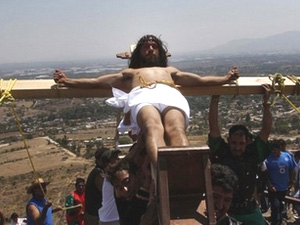Celebrating Easter in Mexico
 Allan Wall - PVNN Allan Wall - PVNN


| | People reenact the crucifixion of Jesus Christ during Holy Week celebrations in Tepotzotlan, Mexico, Friday, March 21, 2008. Holy Week commemorates the last week of the earthly life of Christ culminating in his crucifixion on Good Friday and his resurrection on Easter Sunday. (AP/Marco Ugarte) | | |
The crucifixion, burial and resurrection of Jesus Christ are foundational to the Christian faith. That’s why the major branches of Christendom (Roman Catholic, Protestant and the Eastern Churches) memorialize – in various ways – the death, burial and resurrection of Christ each spring.

Mexico has a variety of traditional Easter customs, many of them deriving from Spain, with a diversity of traditions linked to particular regions and cities.

The Easter season begins on Miércoles de Ceniza (Ash Wednesday) and continues through Cuaresma (Lent), the 40-day period until Semana Santa (Holy Week).

In Mexico, there are certain foods associated with Cuaresma, some of which developed as a result of Catholic dietary rules. Since red meat was prohibited on certain days, fish-based dishes became popular Lenten foods. Mexican grocery stores do a brisk business selling fish during Cuaresma.

Ironically, Catholics were forbidden to eat red meat on certain days as a sacrifice, yet the rules promoted the development of fish-based dishes just as elaborate, if not more so, than the red-meat based dishes they replaced.

Semana Santa (Holy Week) begins on Domingo de Ramos (Palm Sunday), the day of Christ’s Triumphal Entry into Jerusalem. The Last Supper was held on Jueves Santo (Maundy Thursday).

Viernes Santo (Good Friday) commemorates the day of Christ’s crucifixion. Sábado de Gloria (Holy Saturday) memorializes the full day Christ was in the tomb. Domingo de Pascua (Easter Sunday) celebrates the Resurrection of Christ.

On Domingo de Ramos, vendors outside churches sell woven palm leaves, and inside the priest blesses them. On Jueves Santo, Viernes Santo, Sabado de Gloria, and Domingo de Pascua, there is a special mass each day.

On Sabado de Gloria, statues of Mary are covered with black dresses, because she is considered to be in mourning.

Elementary schools, Middle Schools and High school students in Mexico get a two-week vacation, the weeks preceding and following Easter Sunday. Most university students only have the week preceding Easter free. I know my students were quite glad to be getting a vacation!

There are many regional Holy Week customs in Mexico. For example, Tarahumara Indians, in the mountains of Chihuahua, paint themselves white during Holy Week. In some cities, there is a Procesión de Silencio, a silent procession, wherein the people march down the street by candlelight, in silence. This custom is from the Spanish city of Sevilla, famous for Semana Santa observances.

Another tradition still popular in southern Mexico is the "burning of Judas," practiced on Sábado de Gloria, in which effigies of Judas (with firecrackers inside!) are burnt. The Judas effigy is often in the form of a contemporary person, frequently an unpopular politician. It should be interesting to see who gets burnt in effigy this Sábado de Gloria.

Another custom is the Via Crucis, Way of the Cross, a procession in which an actor portraying Christ bears a cross down a street. In some locales this is part of a Passion Play, a dramatic representation of the crucifixion of Christ.

The most famous Passion Play in Mexico is in the Mexico City borough of Ixtapalapa. It has been performed annually since Ixtapalapa survived a cholera outbreak in 1833. The Ixtapalapa Passion Play is a true community endeavour, organized and carried out annually by the locals. It’s sponsored by the secular Iztapalapa government, but not officially sanctioned by the Catholic Church. The drama includes 4000 locals as actors, and reportedly draws 2 million spectators.

All the pageant’s actors must have been born in Iztapalapa. Whoever portrays Christ is selected on the basis of both good moral character and physical strength. The actor wears an actual crown of thorns, is flogged, and bears a 200 pound cross through the streets, before being “crucified” (tied to the cross, not nailed.)

The Ixtapalapa Passion Play is truly a sight to behold. When a reporter asked a local man about it, he replied, "We pray, we cry, as if all this is real. We know it is not. But yet... maybe we come because we are all sinners. Maybe somehow it helps us make fewer sins in our lives... Maybe, just maybe, people are better because of it."

In closing, I wish all my readers a Happy Easter. In the words of the traditional Mexican greeting: ¡Felices Pascuas de Resurrección!
 Allan Wall is an American citizen who has been teaching English in Mexico since 1991, and writing articles about various aspects of Mexico and Mexican society for the past decade. Some of these articles are about Mexico's political scene, history and culture, tourism, and Mexican emigration as viewed from south of the border, which you can read on his website at AllanWall.net. Allan Wall is an American citizen who has been teaching English in Mexico since 1991, and writing articles about various aspects of Mexico and Mexican society for the past decade. Some of these articles are about Mexico's political scene, history and culture, tourism, and Mexican emigration as viewed from south of the border, which you can read on his website at AllanWall.net.

Click HERE for more articles by Allan Wall. |



